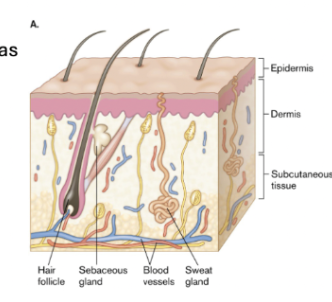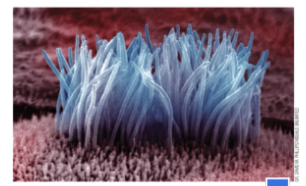Human microbiomes
1/31
There's no tags or description
Looks like no tags are added yet.
Name | Mastery | Learn | Test | Matching | Spaced |
|---|
No study sessions yet.
32 Terms
Skin as a microbial environment
Difficult to colonize due to dryness, salt, acidity, and protective oils.

Where on the skin are microbes most abundant?
Moist areas like scalp, ears, armpits, genitals, and anal region.
about 10¹² total microbes in moist skin areas.
Common skin microbes
Staphylococcus epidermidis
Cutibacterium acnes → Degrades skin oil; can inflame sebaceous glands and is linked to acne.
Are skin microbes mostly gram positive or negative?
Gram-positive
they bacteria have thick cell walls, making them more resistant to salt and dryness.
Early colonizers of the infant mouth - before teeth
Neisseria spp. (gram-negative cocci)
Streptococcus spp. (gram-positive cocci)
Lactobacillus spp. (gram-positive rods)
Bacteria colonizing the mouth after teeth emerge
Prevotella and Fusobacterium spp.: grow between gums and teeth
Streptococcus mutans: colonizes tooth enamel
Why are teeth an ideal bacterial surface?
Teeth are non-shedding surfaces, allowing bacteria like Fusobacterium to stick and form plaque.
Fusobacterium anchor other microbes to the tooth surface and contribute to plaque formation.
Why can strict anaerobes live in the mouth despite oxygen exposure?
Many live in oxygen-poor pockets (e.g., between teeth and gums) and form protective biofilms.
What is the most common site of infection in humans?
The oral and respiratory track
Dominant microbes in nostrils and nasopharynx
Bacillota and Actinomycetota dominate these regions.
usually one species dominates over another in each individual
Nasopharynx (behind nose) microbial residents
Staphylococcus aureus
Staphylococcus epidermidis (some strains promote health)
Oropharynx (behind bouth) microbial composition
Similar to that of saliva.
meningococcus
Casually lives commensally in 10% of adults
Typically harmless, but can cause disease unpredictably
Are lungs a sterile enviornment?
they were once believed to be, but now we know that there is mainly anaerobic population there.
Why was lung microbiota only recently discovered?
Constant action of the mucociliary escalator sweeps microbes upward, making detection harder.
like a cough uses cilia and mucus to move particles toward throat

Lung microbiota in disease
for each kind of lung related disease the microbiota looks different from that of a healthy lung
: Are the kidneys and urinary bladder sterile?
yes, or almost sterile.
Microbes in the urethra
S. epidermis and Enterobacteriaceae can be found in urethra, which may cause UTIs
Vaginal microbiota and the menstrual cycle
The composition of the vaginal microbiota changes with the menstrual cycle.
Role of Lactobacillus spp. in the vaginal microbiota
Lactobacillus spp. thrive in an acidic environment (low pH), which is created by acidic secretions in the vaginal lining. This acidic condition helps the bacteria grow and protect against infections by maintaining a healthy vaginal microbiota.
How can the gut cause UTI
because of the proximity of the exit of the gut (anus) and the urethra there can be cross contamination
Which microbiome is the only one where diversity is not considered a good thing?
The vaginal microbiome
Why is diversity in the vaginal microbiome not considered a good thing?
High diversity in the vaginal microbiome, especially in CST4, can indicate Bacterial Vaginosis and increase the risk of infections, reproductive issues.
CST1 (most common) and 3 are common and normal.
Which microbiome creates a tough environment for microbes ot thrive?
Stomach microbiome
Why do few microbes survive in the stomach?
The stomach has a very low pH (around 1), which makes it a harsh environment for most microbes.
which is intentional to keep out harmful microbes from our mouth.
How does Helicobacter pylori survive in the stomach?
survives at pH 1 by burrowing into the stomach’s protective mucus lining, this can cause gastric ulcers.
Pylori changes juices in the stomach and creates ammonia - which means it creates a neutral pH in the area just around itself allowing it to survive.
Hypochlorydia
decreased stomach acidity, which can be caused by malnourishment or the use of proton pump inhibitors (PPIs). It can lead to intestinal diseases.
How does microbial diversity change from mouth to anus?
Microbial diversity gradually increases as you move from the mouth to the anus.
Which is the most important human microbiome
the colon - gut micrbiome
What is the ratio of anaerobes to facultative anaerobes in the lower intestine?
There is a ratio of 1000 anaerobes to 1 facultative anaerobe in the lower intestine.
Why is the gut microbiome considered the "forgotten organ"?
because it doesnt get credit for the amount of work it does, it functions just as much as the average liver